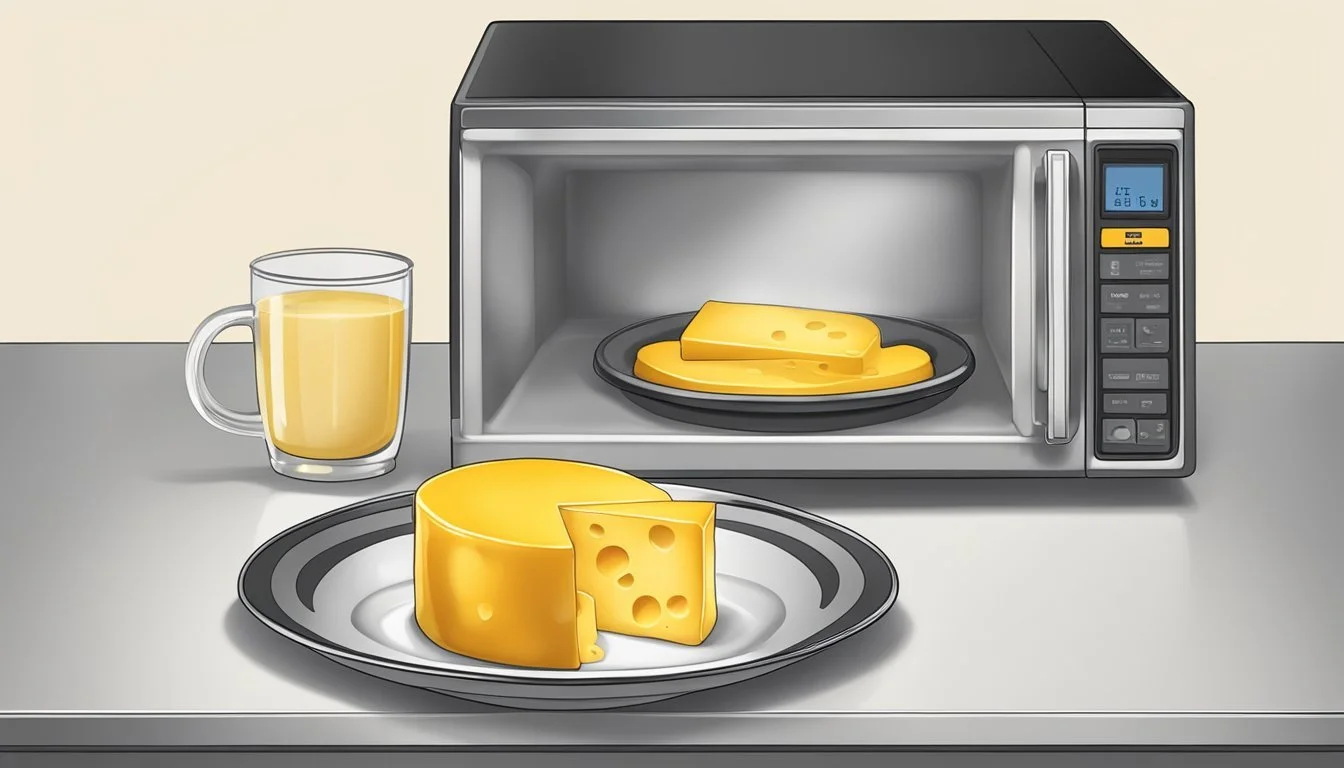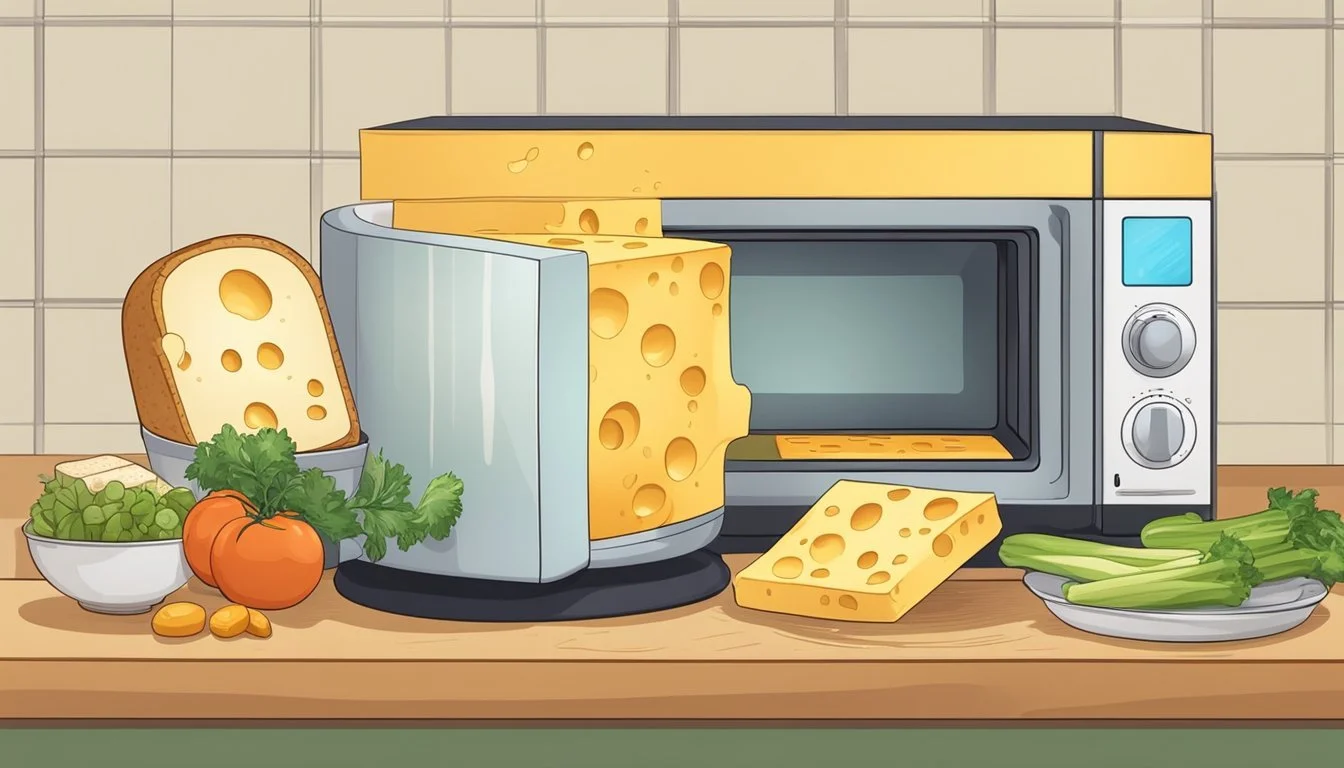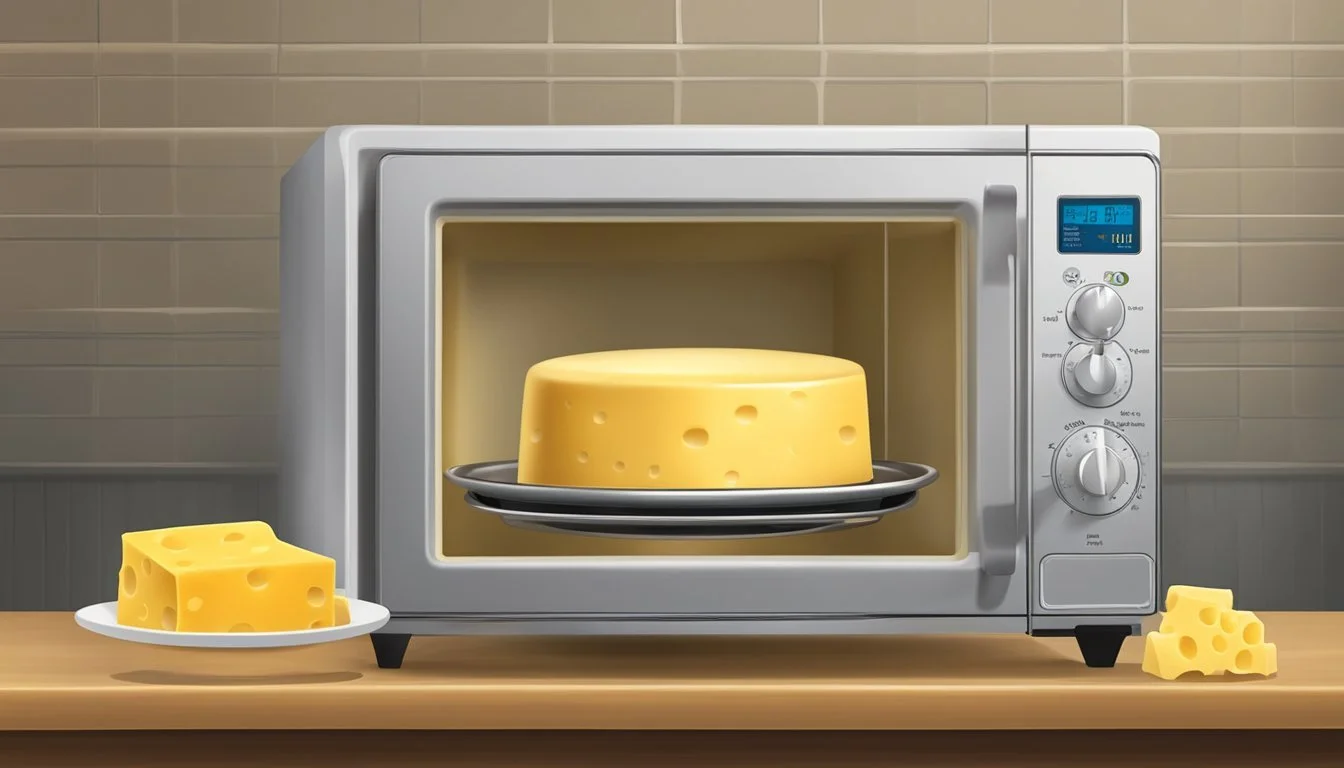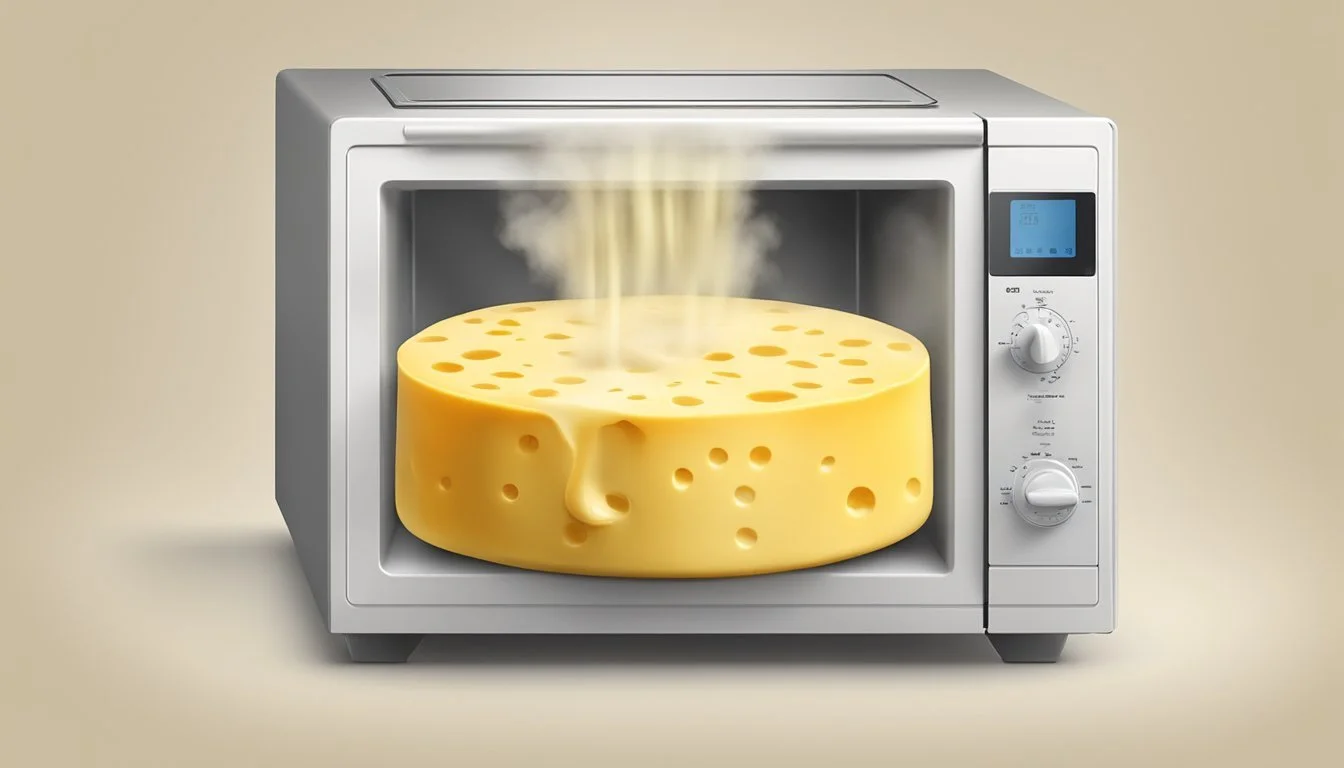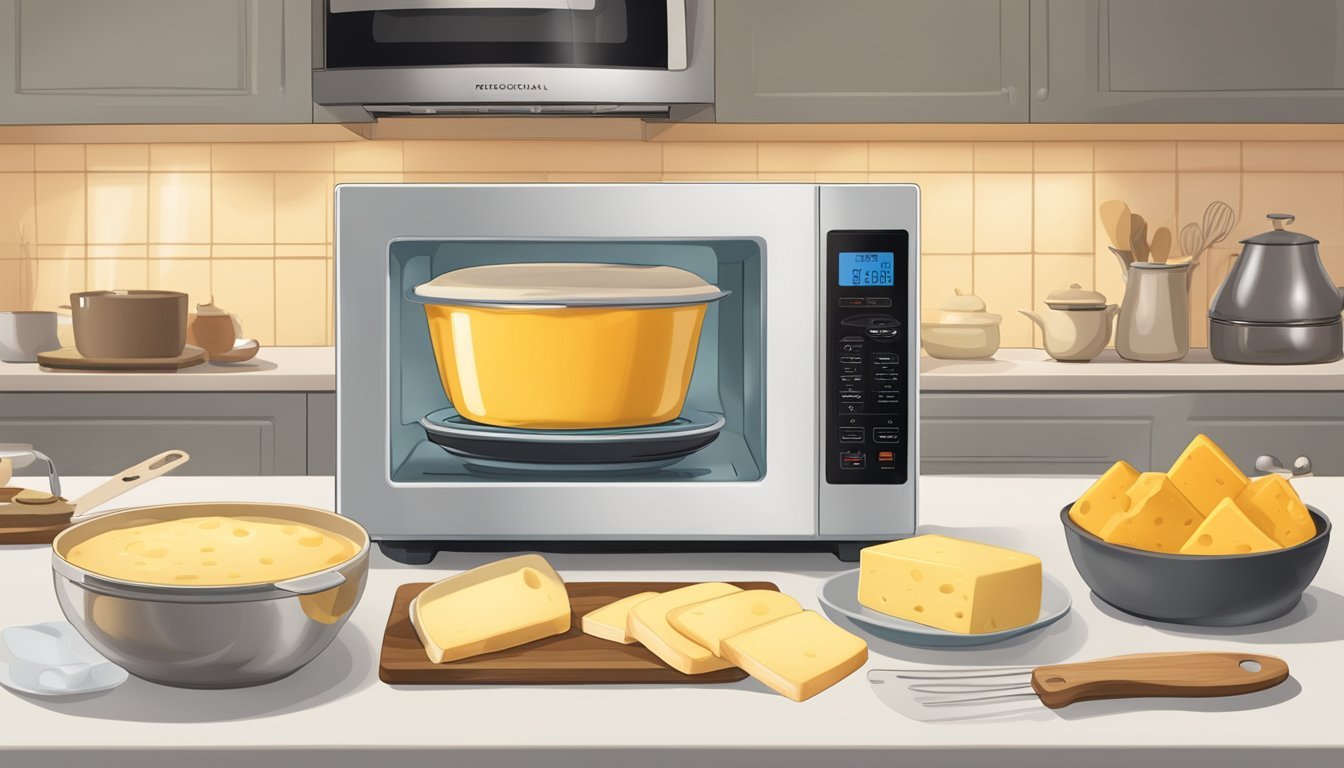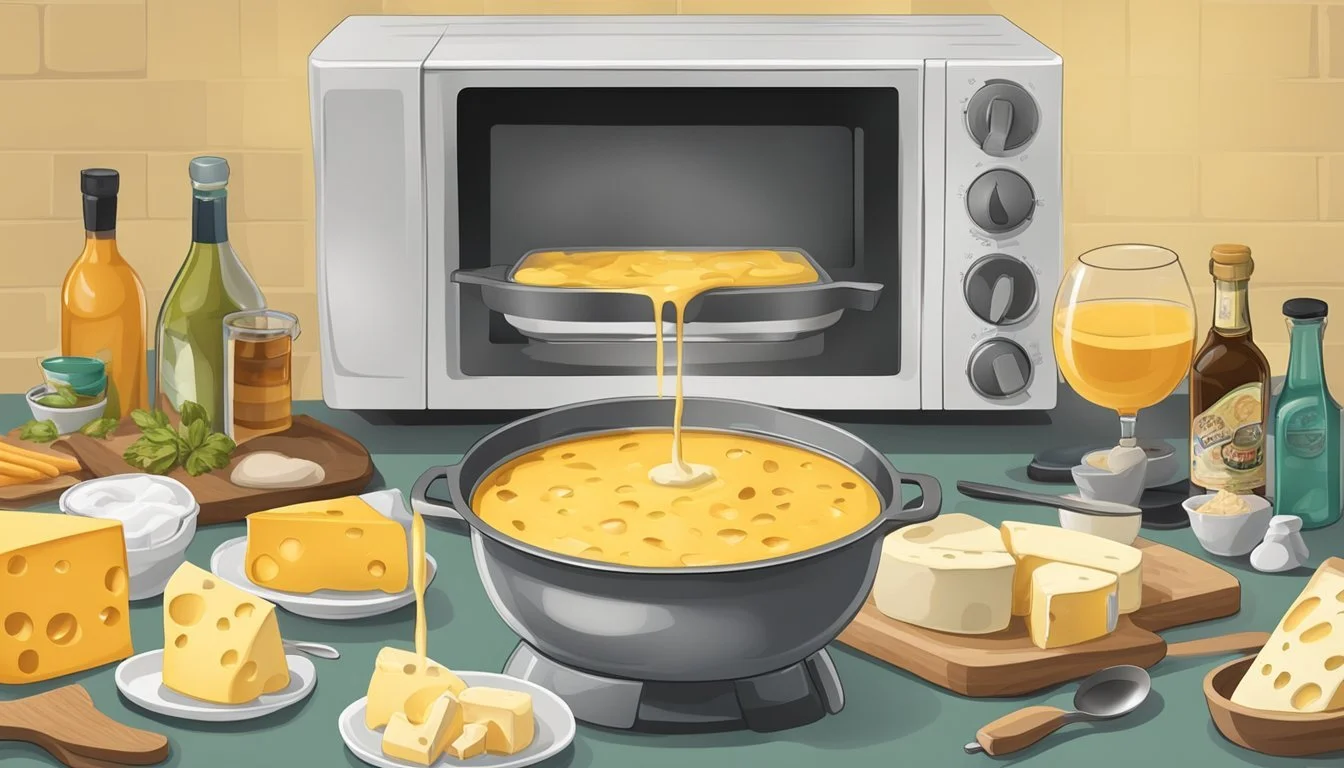The Faux Fondue
Effortless Microwave Cheese Melting Technique
Cheese (What wine goes well with cheese?) fondue is a classic dish that evokes images of communal dining and indulgence in rich, melted cheese. Traditionally, fondue is a Swiss creation that is prepared in a communal pot (fondue pot) over a portable stove, melted to perfection, and enjoyed by dipping various accompaniments like bread, vegetables, or meats. However, not everyone has access to a fondue set or the time it takes to prepare it in the classical way.
The innovative solution for cheese fondue enthusiasts is "The Faux Fondue," which simplifies the experience by using a microwave and a pot. This approach caters to the convenience of modern living without compromising on the delight of dipping into a warm, smooth cheese mixture. The microwave method is surprisingly effective for melting the cheese to the right consistency, making it an excellent alternative for those seeking the pleasure of fondue without the traditional equipment.
While it may stray from the conventional method, the fundamentals of cheese fondue remain central to the process. Quality cheese, properly combined with ingredients such as cornstarch or flour, and careful heating are still essential to achieving the desirable creamy texture. This method opens the door to enjoying cheese fondue anytime with minimal fuss, demonstrating that fondue can be both accessible and enjoyable, regardless of the kitchen tools at hand.
Understanding the Basics of Fondue
Fondue, a dish of melted cheese, requires essential ingredients and equipment to delight one's palate. It carries a significant cultural history and relies on a delicate balance of flavors and textures for that perfect melt.
History and Popularity of Cheese Fondue
Cheese fondue originated in Switzerland as a way to utilize aged cheeses and bread during the winter months. It has since become a symbol of Swiss culinary heritage, appreciated worldwide for its communal dining experience. The preparation involves melting cheese in a communal pot, known as a fondue pot, and dipping various accompaniments into the cheese.
Key Ingredients for Classic Fondue
The key to a successful cheese fondue lies in its ingredients, each serving a specific purpose to achieve the desired creamy consistency and depth of flavor.
Cheeses:
Gruyère: A staple Swiss cheese, it's known for its superb melting characteristics.
Emmental: Another Swiss variety that adds a distinct nutty flavor.
Liquid Base:
White Wine: Typically, a dry wine is used, giving the fondue a tart kick and aiding in the cheese melting process.
Lemon Juice: Sometimes added to balance the richness of the cheese with its bright acidity.
Thickening Agents:
Cornstarch: Helps in stabilizing and thickening the cheese mix.
Seasonings:
Garlic: Rubbed in the fondue pot or added to the sauce, garlic is essential for the foundational flavor.
Black Pepper and Nutmeg: Both are often used to enhance the fondue with warmth and complexity.
Dry Mustard: Gives an extra depth of flavor to the fondue.
These ingredients are traditionally combined in a fondue pot, where they meld together over a gentle heat source to create a smooth, consistent fondue that can be enjoyed with a variety of dippables like bread, vegetables, and meats.
Microwave Melting Technique
The Microwave Melting Technique offers a quick and reliable method to prepare a delectable melted cheese experience, often similar to what one might enjoy from a fondue made in a traditional melting pot.
Safe Microwave Practices
When using a microwave to melt cheese, the user should prioritize safety and efficiency. It is essential to use microwave-safe containers to prevent any mishaps or contamination of the cheese. A typical practice involves melting cheese in short intervals, stirring frequently to ensure even heat distribution. This minimizes the risk of overheating and ensures that the cheese melts uniformly.
Do:
Use microwave-safe bowls or dishes.
Heat in short bursts (usually 30-second intervals).
Stir between intervals to distribute heat.
Don't:
Microwave in containers with metallic elements.
Overheat without checking, as this can lead to burning or separation.
Leave the microwave unattended.
Maintaining Cheese Texture and Flavor
To ensure that the melted cheese retains its rich texture and full flavor, one must consider the type of cheese and the power of the microwave. Cheeses that are good for melting, such as cheddar or gouda, can be combined with a bit of cream to keep the mixture smooth and to avoid oiliness or separation of ingredients. Moreover, by adjusting the microwave power setting to medium, the cheese can melt gently, helping maintain its creamy consistency and prevent scorching.
Adjustments for Texture and Flavor:
Add a small amount of cream or milk to the cheese before microwaving.
Microwave on a medium power setting.
Stir in any additional ingredients like herbs or spices after the cheese has melted.
By employing these specific microwave techniques, anyone can easily create a savory cheese fondue with minimal effort and cleanup.
The Role of Accompaniments
Accompaniments play a crucial role in enriching the fondue experience, offering a variety of textures and flavors that complement the creamy cheese.
Selecting Your Dippers
Choosing the right dippers is essential for a satisfying fondue. The most common and versatile dipper is bread, with options such as:
French bread
Multigrain
Sourdough
Bagel pieces
Bread cubes
For a healthier selection, one can turn to vegetables like:
Carrots (light and crunchy)
Broccoli and cauliflower (florets capture cheese well)
Potatoes (boiled or roasted)
Fruits like apple slices add a sweet contrast and cleanse the palate between bites.
Balancing Flavors with Your Fondue
A harmony of flavors is achieved by pairing fondue with dippers that either complement or contrast the taste of the cheese.
Bread: Neutral in taste; good for strong cheeses.
Veggies: Earthy flavors that balance rich cheese.
Fruit: Apples impart a tart freshness against creamy textures.
Meat: Cooked pieces add a protein component and a hearty taste.
Each dipper should be considered for how it will interact with the fondue's flavor profile; bread cubes from a crusty French bread or the natural sweetness of apple slices can enhance the overall dining experience.
Pairing Beverages with Cheese Fondue
Choosing the right beverage to accompany cheese fondue can enhance the flavors and transform the dining experience. One must consider the type of cheese and the additional ingredients used in the fondue to select an appropriate wine or beer.
Wine and Fondue Pairings
When pairing wine with cheese fondue, dry white wines are often recommended. They balance the richness of the cheese without overpowering its flavor.
Notable Pairings:
Dry White Wine: A classic choice is a crisp, dry white wine such as Sauvignon Blanc or Chardonnay. The acidity of these wines cuts through the cheese's creaminess.
Table of Wine Pairings:
Cheese Type Suggested Wine Traditional Swiss Fendant or Gruyère Sharp Cheddar Sauvignon Blanc Gouda or Edam Dry Riesling
One should serve wine chilled to bring out its refreshing qualities, which in turn complements the warm fondue.
Beer Options for a Twist on Tradition
Beer offers a diverse range of flavors that can complement cheese fondue. Lighter beers like lagers are versatile and can pair well with milder cheese fondues.
Beer Suggestions:
Light Lager: A beer like Bud Light is subtle enough to not clash with discrete cheese flavors.
For heartier cheese mixtures, one might opt for ales or stouts which provide more body and complexity. The carbonation in beer also helps to refresh the palate between bites. One can experiment with local craft beers to find unique pairings that please their palate.
Advanced Fondue Techniques
Mastering the nuances of fondue preparation can transform an ordinary cheese dip into a gourmet experience. The section below details how to leverage a traditional fondue pot for optimal results.
Using a Traditional Fondue Pot
When using a traditional fondue pot, it's crucial to understand the proper heat management necessary for a smooth and delectable cheese fondue. Whether it is an electric fondue pot or a manual one, maintaining a consistent temperature is key to avoid burning or undercooking the cheese.
For those using an electric fondue pot, such as the Cuisinart CFO-3SS Electric Fondue Maker, precision in temperature control is one of its standout features. Here's a step-by-step process to achieve fondue perfection:
Begin by grating the cheese of choice and toss it with an appropriate amount of cornstarch or flour -- this assists in even melting and prevents clumping.
Heat the Base
Start the pot on a medium-high setting and add a liquid base (beer, wine, or broth) to the fondue pot along with some garlic for flavor infusion.
For the Cuisinart CFO-3SS, utilize its adjustable temperature control to find the optimal heat level for your chosen recipe.
Add and Melt Cheese
Once the liquid is at a simmer, reduce to medium heat and introduce the cheese gradually to the pot, continuously whisking for a smooth consistency.
Monitor Consistency
Regular stirring is essential with fondue; it not only blends the flavors but also ensures the cheese doesn't settle at the bottom and burn.
If using an electric fondue pot, one can often benefit from a built-in thermostat that helps maintain the perfect temperature for melting without the risk of scorching the cheese.
Serve and Enjoy
Once the fondue reaches the desired creaminess, it's ready to be served. Keep the pot on a low setting to maintain the fondue's temptingly gooey texture throughout the meal.
By adhering to these techniques, one can confidently prepare a fondue that is sure to impress with its rich flavor and perfect consistency.
Recipes and Variations
This section offers a selection of fondue recipes, including a time-honored Swiss cheese fondue and creative variations. Each recipe is designed for simplicity, being mindful of different dietary preferences and kitchen equipment availability.
Classic Swiss Cheese Fondue
To prepare a classic Swiss Cheese Fondue, one needs Gruyère and Emmentaler cheese. A simple recipe involves:
200g Gruyère cheese, shredded
200g Emmentaler cheese, shredded
1 clove of garlic, halved
300ml dry white wine
1 tablespoon lemon juice
2 teaspoons cornstarch
1 tablespoon kirsch (optional)
Freshly ground black pepper
Grated nutmeg
French bread for dipping
Rub the inside of the pot with the garlic halves, add white wine and lemon juice, and heat until hot but not boiling. Gradually add the cheeses, stirring until melted and smooth. Mix cornstarch with kirsch (or a bit of wine) to form a slurry, add to the fondue, and cook until thickened slightly. Season with pepper and nutmeg to taste.
Innovative Fondue Ideas
Creative variations of fondue use different cheese and liquid combinations. For a Beer Cheese Fondue, substitute the white wine with a lager and use Cheddar cheese, fontina, or gouda, adapting to one's taste. To make a Cheddar Cheese Fondue, one could use:
200g Cheddar cheese, shredded
200g Fontina or Gouda cheese, shredded
1 teaspoon cornstarch
1 cup beer, preferably a lager or ale
2 teaspoons dry mustard
1 teaspoon Worcestershire sauce
Crusty bread, vegetables, and apple slices for dipping
Mix cheeses with cornstarch. Warm beer in the pot, add mustard and Worcestershire sauce, then the cheese blend. Stir until each addition has melted into a seamless emulsion.
Non-Cheese Fondue Alternatives
For those looking for something sweet or with no cheese, Chocolate Fondue is a delightful alternative. The recipe generally includes:
200g good-quality dark chocolate, chopped
100ml heavy cream
2 tablespoons of a preferred liqueur (like Grand Marnier or Amaretto)
Fruits and marshmallows for dipping
Comine chocolate and cream in a microwave-safe bowl, heat in 20-second intervals, stirring until smooth. Stir in the liqueur, then serve warm with dippers.
By employing different cheeses, liquids, and dippers, one can craft fondue that suits various palates and occasions, whether looking for traditional iterations with Swiss and Gruyère or branching out into other cheese options and even non-cheese variations.
Tips for Hosting a Fondue Party
When planning a fondue party, having the right equipment is crucial, as is setting the perfect mood for your guests. Success hinges on balancing practicality with an inviting ambiance.
Essential Equipment
The foundation of any fondue party is the fondue set, which includes a pot heated by a candle or alcohol burner to keep the cheese at the ideal melting temperature. While microwaves can create a quick faux fondue, traditional sets are recommended for the authentic experience. Guests need fondue forks for dipping; color-coded or personalized options help prevent mix-ups. For the fondue dipper, a variety of breads, vegetables, and meats can be prepared as appetizers or a full meal.
Fondue Set Components
Pot: Ceramic or metal, suitable for cheese or chocolate.
Burner: Provides consistent heat; consider safety and fuel type.
Forks: Long-stemmed with heat-resistant handles.
Dipper Ideas
Bread cubes: Sourdough, baguette, or rye.
Vegetables: Bell peppers, broccoli, or cherry tomatoes.
Meats: Cooked meats like chicken, beef, or meatballs.
Creating an Inviting Atmosphere
The ambiance at a fondue party should encourage communal dining and interaction. Setting up the fondue station as a central focal point invites guests to gather around. Soft lighting and background music enhance the cozy feel. For the melting pot cheese fondue, consider offering a copycat recipe that replicates the flavors from popular fondue restaurants, adding a touch of authenticity to the meal.
Centerpiece: The fondue pot, accessible from all sides.
Lighting: Candles or dimmed lights for warmth.
Music: Low-volume, non-intrusive background music.
Troubleshooting Common Fondue Issues
Cheese fondue is an indulgent treat that requires precision to achieve perfect texture and flavor. However, even skilled chefs can face common issues like cheese separation or dealing with leftovers. Here's how to tackle these fondue frustrations confidently.
Preventing Cheese Separation
Tips and Tricks:
Grate the cheese finely to encourage even melting, utilizing the larger holes of a grater for consistency.
To stabilize the fondue, add a teaspoon of lemon juice or a slurry of white wine and cornstarch (3 tablespoons of cornstarch to ¼ cup (60 ml) cold white wine) for each 1 ½ pounds (650 grams) of grated cheese.
Maintain a moderate temperature when melting. Excessive heat can cause the cheese to separate, while not enough heat may leave it lumpy.
Rating and Comment Advice:
When guests rate the fondue or leave comments, note any recurring mention of texture. If separation is a common issue, reassess the balance of heat, acidity, and stabilizers in the recipe.
Dealing with Leftovers
Storage Tips:
Cool the fondue to room temperature and transfer it to an airtight container. Store in the refrigerator for up to 5 days.
To reheat, carefully warm the leftover fondue in a pot over low heat to avoid separating the cheese.
Transform the fondue into a creamy sauce for pasta or vegetables by gently reheating and adjusting thickness with a splash of milk or cream.
Incorporate extras into omelettes or savory pastries for a flavorful twist.
When guests inquire about what to do with their leftovers or rate their experience, comments often reflect an appreciation for these practical and delicious solutions.
Dietary Considerations and Nutrition
When enjoying cheesy appetizers like a faux fondue made in a microwave and pot, it's crucial for diners to consider their dietary restrictions and the nutritional content of the ingredients used. This section explores gluten-free and vegan options along with the nutritional aspects of cheese fondue.
Gluten-Free and Vegan Options
For those with gluten sensitivity or celiac disease, ensuring that all ingredients are gluten-free is essential. Cheeses and other additives generally do not contain gluten, but it's vital to check labels as some processed cheeses may use gluten as a thickener. Gluten-free thickeners include options like cornstarch or arrowroot. If beer is used in the recipe, it must be a certified gluten-free variety.
Vegan diners can opt for plant-based cheese alternatives which are often made from nuts, soy, or tapioca. When selecting a vegan cheese for fondue, one should ensure it has good melting properties similar to traditional cheese. Vegan cheeses vary in how well they melt and integrate into a dish, so it helps to research or experiment with different brands and types.
Understanding Nutrition Content
Nutrition Information:
Traditional cheese fondue can be high in calories and fat due to the dense nature of cheese. It's essential to consider portion sizes and the types of cheese used to manage the dish's energy density.
Nutrient Approx. Amount per Serving Calories 300-400 Total Fat 25-35g Saturated Fat 15-22g Carbohydrates 2-4g Protein 18-25g Sodium 350-550mg
Please note that these values can vary depending on the ingredients and portion sizes
In a faux fondue, the nutrition content can be adjusted by using reduced-fat cheese options which lower the total and saturated fat content; however, this may also affect the melting quality and taste. Cheesy appetizers like fondue can also be enriched with vegetables such as spinach or artichokes to increase the dish's fiber and nutrient content, creating a more balanced offering.
Engaging with Fondue Enthusiasts
For cheese fondue aficionados looking to share their microwave and pot creations, engaging with online communities presents an excellent opportunity to exchange recipes, tips, and connect with like-minded individuals.
Online Resources and Communities
Online platforms offer a wide array of resources where enthusiasts can explore and expand their fondue repertoire. Pinterest serves as one of the key players in this space, providing a visual smorgasbord of cheese fondue recipes and presentation ideas. Users can curate their boards with fondue variations and "pin" their favorite content for later. The platform allows users to rate the recipes they try, which can then guide others in making choices about which fondue concoctions to explore next.
In depth discussions about fondue methods, cheese types, and creative twists typically take place in the comment sections. Here, enthusiasts not only exchange praise or constructive feedback but also troubleshoot common issues associated with microwave cheese fondue preparation. Comment threads can be particularly valuable for beginners seeking advice from more experienced peers.
Furthermore, many online communities enable users to share personal twists on classic recipes and offer support through rating systems, often a 1 to 5-star scale. This feedback loop creates a dynamic and interactive environment where one's fondue skills can be honed and celebrated.

